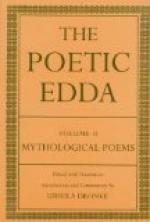If the theory stated below as to the original Helgi legend be correct, the feud with Hunding’s race, as told in these poems, must be extraneous. I conjecture that it belonged originally to the Volsung cycle, and to the wer-wolf Sinfjoetli. It must not be forgotten that, though he passes out of the Volsung story altogether in the later versions, both Scandinavian and German, he is in the main action in the earliest one (that in Beowulf), where even Sigurd does not appear. The feud might easily have been transferred from him to Helgi as well as to Sigurd, for invention is limited as regards episodes, and a narrator who wishes to elaborate the story of a favourite hero is often forced to borrow adventures. In the original story, Helgi’s blood-feud was probably with the kindred of Sigrun or Svava.
The origin of the Helgi legend must be sought outside of the Volsung cycle. Some writers are of opinion that the name should be Holgi, and there are two stories in which a hero Holgi appears. With the legend of Thorgerd Holgabrud, told by Saxo, who identified it with that of Helgi Hundingsbane, it has nothing in common; and the connection which has been sought with the legend of Holger Danske is equally difficult to establish. The essence of this latter story is the hero’s disappearance into fairyland, and the expectation of his return sometime in the future: a motive which has been very fruitful in Irish romance, and in the traditions of Arthur, Tryggvason, and Barbarossa, among countless others. But it is absent from the Helgi poems; and the “old wives’ tales” of Helgi’s re-birth have nothing to do with his legend, but are merely a bookman’s attempt to connect stories which he felt to be the same though different.
The essential feature of the story told in these poems is the motive familiar in that class of ballads of which the Douglas Tragedy is a type: the hero loves the daughter of his enemy’s house, her kinsmen kill him, and she dies of grief. This is the story told in both the lays of Helgi Hundingsbane, complete in one, unfinished in the other. No single poem preserves all the incidents of the legend; some survive in one version, some in another, as usual in ballad literature.
Like Sinfjoetli and Sigurd, Helgi is brought up in obscurity. He spends his childhood disguised in his enemy’s household, and on leaving it, sends a message to tell his foes whom they have fostered. They pursue him, and he is obliged, like Gude Wallace in the Scottish ballad, to disguise himself in a bondmaid’s dress:
“Piercing are the eyes of Hagal’s bondmaid; it is no peasant’s kin who stands at the mill: the stones are split, the bin springs in two. It is a hard fate for a warrior to grind the barley; the sword-hilt is better fitted for those hands than the mill-handle.”
Sigrun is present at the battle, in which, as in the English and Scottish ballads, Helgi slays all her kindred except one brother. He tells her the fortunes of the fight, and she chooses between lover and kinsmen:




